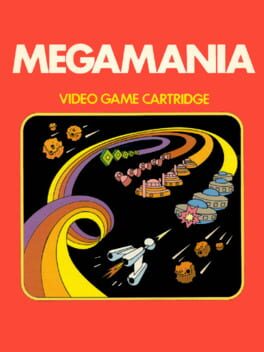

In Megamania, the gameplay resembles that of Space Invaders. Rather than being aliens or spaceships, however, the enemies in this game are various objects such as hamburgers, bow ties, and steam irons. The object is to shoot them down before the energy bar at the bottom of screen is depleted, all while avoiding the oncoming enemies and their own projectiles attacks. Each of the enemies fly in select patterns and as soon as they hit the bottom of the screen, they re-appear at the top until shot by the player. The player's spacecraft depicted in the game is a cross between the U.S.S. Enterprise and Klingon battlecruiser from the Star Trek universe. Gameplay-wise and in terms of graphics, MegaMania bears a very strong resemblance to Sega's 1981 arcade title "Astro Blaster". Both games feature nearly identical patterns of approaching enemies with the player relying on an "Energy" meter. Also, the player's ship bears a remarkable similarity in both games. When Megamania was originally sold, anyone who scored above 45,000 points could send Activision a picture of their screen and become an official Megamaniac. They also would receive an Official Megamaniac emblem.[2] If a player exceeds a score of 999,999 the game ends.
Reviews View More
Strictly speaking, developer Steve Cartwright got the idea for this game off Astro Blaster, not Space Invaders. But Space Invaders makes for a fairly easy shorthand these days: fixed-screen space shooter dealing with waves of alien enemies, where each of the enemies is modeled after normal Earth things (in Space Invaders' case, sealife; in MegaMania's case, food and household objects). On top of the waves of enemies moving in different patterns (and some decent stuff there - I like seeing the Space Dice roll through), the gimmick for MegaMania is its Guided Missiles in Games 1 & 2, which follow the player's movements.
This ain't bad, but it is strikingly weird. Straightforward enough to program, since it's basically just applying the player's movement to a second sprite, but pretty different from how a lot of games think of their projectiles. I can't tell you how many times I went to line up a shot and retreat from counterfire, only for this to make my missile weave around the enemy. You kind of have to play less defensively than you do in a lot of these space shooters to make the Guided Missiles work. Kinda different than my usual playstyle, but not bad - gives the game its own identity, firing and tracking down an enemy to line up your shot. But if you're not a fan, you can just pick Games 3 & 4 for Straight Missiles, which completely ignore the player's inputs. Nice to have the option.
I kinda wish there was more of a story to this. It's ultimately pretty inconsequential, since a lot of these early games don't really need a narrative, but I love seeing how much effort Atari would put into manuals of this era (the Swordquests and Yar's Revenge come to mind). I haven't played a lot of Activision's efforts in this era; maybe this was pretty typical for them? Nice of them to actually credit Steve Cartwright, though.
Let the record show, my play improved substantially after I muted the game audio and played Buddy Holly's "Everyday" in the background, so maybe Opal's onto something. Ended up with over 62,000 points, so per the manual, I am eligible to become an official MegaManiac. I expect Activision to send me the official emblem in the mail in 8 to 10 business days.
